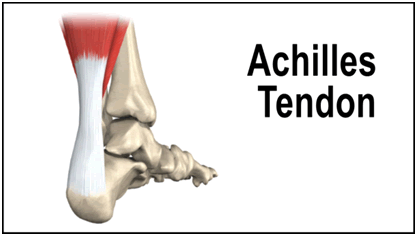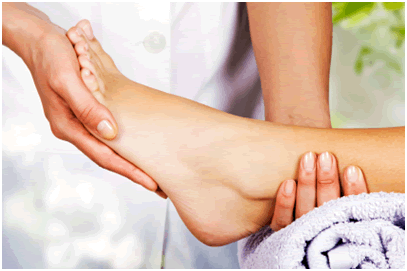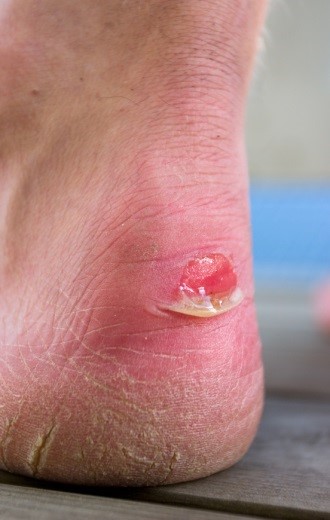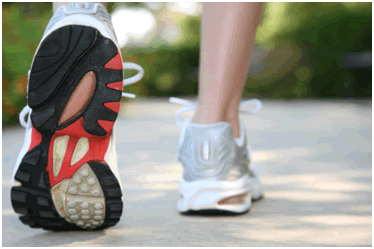Items filtered by date: February 2015
Governor Rick Snyder tears Achilles Tendon
 After jogging during a vacation in Florida, Michigan governor Rick Snyder reportedly felt a "pop" in his right foot. Following visits with doctors in both Florida and Michigan, the Republican governor has discovered that his right Achilles tendon is torn. Snyder says jogging is part of his Healthy Michigan, but has told The Detroit News that he "overdid it." According to spokeswoman Sara Wurfel, Snyder describes the pain as "not horrible." The Michigan governor has been mentioned as a potential candidate for the 2016 presidential election. When asked about running, he responded that he's "working on literal running first."
After jogging during a vacation in Florida, Michigan governor Rick Snyder reportedly felt a "pop" in his right foot. Following visits with doctors in both Florida and Michigan, the Republican governor has discovered that his right Achilles tendon is torn. Snyder says jogging is part of his Healthy Michigan, but has told The Detroit News that he "overdid it." According to spokeswoman Sara Wurfel, Snyder describes the pain as "not horrible." The Michigan governor has been mentioned as a potential candidate for the 2016 presidential election. When asked about running, he responded that he's "working on literal running first."
Achilles tendon injuries can be very painful. If you believe you are having problems with this condition, consult with Dr. Joshua David Scoll of Pennsylvania. Dr. Scoll can treat your foot and ankle needs.
What is the Achilles Tendon?
The Achilles tendon is a tendon that connects the lower leg muscles and calf to the heel of the foot. It is the strongest tendon in the human body, and is essential for making movement possible. Because this tendon is such an integral part of the body, any injuries to it can cause severe difficulties and should immediately be presented to a doctor.
What are the symptoms of an Achilles Tendon Injury?
There are various types of injuries that can affect the Achilles tendon. The two most common are Achilles tendinitis and ruptures of the tendon.
Achilles Tendinitis Symptoms
- Inflammation
- Dull to Severe Pain
- Increased blood flow to the tendon
- Thickening of the tendon
Rupture Symptoms
- Extreme pain and swelling in the foot
- Total immobility
Treatment and Prevention
Achilles tendon injuries are diagnosed by a thorough physical evaluation. Often the doctor will order an MRI to confirm the diagnosis. Treatment will involve rest, physical therapy, and in some cases, surgery. However, various preventative measures can be taken to avoid these injuries.
For more information about Achilles Tendon Injuries, follow the link below.
If you have any questions, please contact our offices located in Philadelphia and Bensalem, PA. We offer the newest diagnostic and treatment technologies for all your foot and ankle injuries.
Certain Massaging Techniques can Further Damage in Morton’s Neuroma Patients
 Morton's Neuroma occurs when a nerve between the third and fourth or the second and third toes becomes compressed or injured. Those with Morton's neuroma may typically feel sharp pain, burning, or numbness in the foot and the nerves may thicken causing a visible lump in the foot. According to Dr. Anthony Komaroff of Harvard Medical School, women are at a greater risk because they usually wear tight shoes or high heels. One of the best ways to prevent and treat Morton's neuroma is to wear low heeled shoes with a wider toe box so the bones, ligaments, muscles and nerves, are not squeezed. Dr. K also recommends massaging the area or visiting your foot care professional for metatarsal pads to help correct any structural problems you may have. If the pain persists, doctors may inject a local anesthetic with corticosteroid to reduce inflammation. Surgery may be needed if the previously mentioned methods do not work.
Morton's Neuroma occurs when a nerve between the third and fourth or the second and third toes becomes compressed or injured. Those with Morton's neuroma may typically feel sharp pain, burning, or numbness in the foot and the nerves may thicken causing a visible lump in the foot. According to Dr. Anthony Komaroff of Harvard Medical School, women are at a greater risk because they usually wear tight shoes or high heels. One of the best ways to prevent and treat Morton's neuroma is to wear low heeled shoes with a wider toe box so the bones, ligaments, muscles and nerves, are not squeezed. Dr. K also recommends massaging the area or visiting your foot care professional for metatarsal pads to help correct any structural problems you may have. If the pain persists, doctors may inject a local anesthetic with corticosteroid to reduce inflammation. Surgery may be needed if the previously mentioned methods do not work.
Morton's neuroma can be a difficult condition to live with. If you would like to learn more about your Morton's neuroma and possible treatment options, speak to Dr. Joshua David Scoll of Pennsylvania. Our doctor will diagnose and treat your feet accordingly.
Morton's Neuroma
Morton's neuroma is a painful foot condition that commonly affects the areas between the third and fourth toe and the ball of the foot, although other areas of the foot are also susceptible to this condition. Morton's neuroma is caused by an inflamed nerve in the foot that is being squeezed and aggravated by surrounding bones. Women are more likely than men to have an occurrence of this foot condition.
What Increases the Chances of having Morton's Neuroma?
-Ill-fitting high heels or shoes that add pressure to the toe or foot area.
-Jogging, running and any sports that involve constant impact to the foot area.
-Flat feet, bunions, and any other foot deformity may put you at a higher risk for developing Morton's neuroma.
If you suspect that you may have this condition, you should visit your podiatrist. A podiatrist will first conduct a thorough physical examination to check for palpable masses between the bones of the foot.
If you have any questions, please contact our offices located in Philadelphia and Bensalem, PA. We offer the newest diagnostic and treatment technologies for all your foot care needs.
Glamour Magazine Discusses Best Way to Avoid Blisters Altogether
 Glamour Magazine partnered with Australian Podiatrist, Dr. Phillip Vasyli, to discover the best way to avoid blisters on the feet while wearing new and stylish shoes. He initially stated that making sure the shoe fits properly and breaking them in before wearing them in public or at work are typically good starter points in avoiding blisters. “Checking your feet every day for signs of redness across the toes and heel is a key element in early detection and blister prevention,” stated Vasyli. Many women will see or feel a blister start to arise, ignore it, and will go through their day to find torn skin and potentially damaged shoes later. Vasyli wants readers to pay attention to their feet early on to avoid this. Some companies also make wax based anti-friction sticks to reduce the possibility of a blistery foot.
Glamour Magazine partnered with Australian Podiatrist, Dr. Phillip Vasyli, to discover the best way to avoid blisters on the feet while wearing new and stylish shoes. He initially stated that making sure the shoe fits properly and breaking them in before wearing them in public or at work are typically good starter points in avoiding blisters. “Checking your feet every day for signs of redness across the toes and heel is a key element in early detection and blister prevention,” stated Vasyli. Many women will see or feel a blister start to arise, ignore it, and will go through their day to find torn skin and potentially damaged shoes later. Vasyli wants readers to pay attention to their feet early on to avoid this. Some companies also make wax based anti-friction sticks to reduce the possibility of a blistery foot.
Blisters on the feet can be very uncomfortable and can cause plenty of problems if left untreated. If you sustained blisters on your feet, see podiatrist Dr. Joshua David Scoll of Pennsylvania. Dr. Scoll can treat your foot and ankle needs.
Blisters on the Feet
When tight or ill-fitting footwear is worn, many times a foot blister may develop. Blisters can even develop by constant rubbing from the shoe, often times leading to pain.
What is a Foot Blister?
A foot blister is a small pocket that is filled with fluid, forming on the upper most layer of the skin. Blisters are filled with clear fluid, and may lead to drainage of blood or pus if the area has become infected.
How do they Form?
Blisters of the feet are almost always the result of shoe rubbing and constant friction of the skin and material. Long periods of walking in shoes, sandals, or boots which don’t fit properly can result in a blister. Those who often have moisture or humidity in the feet are prone to blister formation easily.
For more information regarding the prevention and treatment of blisters on the feet, follow the link below.
If you have any questions feel free to contact one of our offices located in Philadelphia and Bensalem, NJ. We offer the latest in diagnostic and treatment technology to meet your needs.
Scientists of the University of Calgary Study Running Shoes
 Faculty of Kinesiology within the University of Calgary have recently showed interest in building the perfect running shoe through studying the effects of comfort and its effect on the rates of injury. Even though the idea of the perfect running shoe has circulated for years, certain studies claim that shoe design has no effect on the rate in which running injuries occur.
Faculty of Kinesiology within the University of Calgary have recently showed interest in building the perfect running shoe through studying the effects of comfort and its effect on the rates of injury. Even though the idea of the perfect running shoe has circulated for years, certain studies claim that shoe design has no effect on the rate in which running injuries occur.
However, comfort has become a very big factor in the type of shoe runners will buy and many suggest that people should just go with the pair of running footwear that feels best for them. The scientific team still wants willing participants for their study, hoping to learn more through research.
For help with selecting an appropriate shoe size, consult with Dr. Joshua David Scoll of Pennsylvania. Dr. Scoll can measure your feet to determine what your needs are and help you find an appropriate pair of footwear.
Getting the Right Shoe Size
Sometimes it may be difficult finding the right shoe size especially because shoe sizes tend to vary depending on the brand and company you are looking for. A size 6 for one brand may be a size 7 in another. Although many people know their exact shoe size, it can range within 2 sizes depending on where they shop.
So it is important not to always go for a size 7 just because you think you might be a size 7 universally. It is best to try on the shoe and walk around for a bit to see how it fits and how it feels. Comfort is essential and the fitting has to be well otherwise it can lead to blisters, bruises at the back of the ankle and it can also hurt your toes if the shoe is too tight for example.
People walk a lot, so it is important for you to find what is comfortable when it is possible.
For more information about Getting the Right Shoe Size, follow the link below.
If you have any questions, please feel free to contact one of our offices located in Philadelphia and Bensalem, PA. We offer the newest diagnostic and treatment technologies for all your foot and ankle needs.
Read more about Choosing the Right Running Shoes
